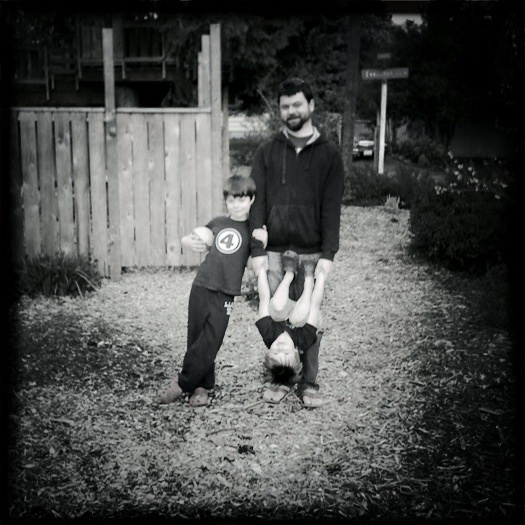Lisa’s fantastic essay, “Say it loud: I’m childfree and I’m proud,” had 196 comments last time I checked. If you haven’t read it, you really should. I’ll wait here.
…
It got me thinking. Pardon a weekend ramble.
 Me and my little resource hogs.I’m a father of two boys and I’ve absolutely loved it. I was making pretty poor use of being childless anyway, and it turns out having kids suits me better than independence ever did. But my first reaction to Lisa’s essay was not defensiveness. It’s not like we’re taking a quiz and there’s only one right answer. Surely it’s good news when anyone discovers their own best life and lives it! In general, it’s good for there to be lots of different kinds of people doing lots of different kinds of things. In particular, the kind of life Lisa’s chosen is complementary to the kind of life I’ve chosen.
Me and my little resource hogs.I’m a father of two boys and I’ve absolutely loved it. I was making pretty poor use of being childless anyway, and it turns out having kids suits me better than independence ever did. But my first reaction to Lisa’s essay was not defensiveness. It’s not like we’re taking a quiz and there’s only one right answer. Surely it’s good news when anyone discovers their own best life and lives it! In general, it’s good for there to be lots of different kinds of people doing lots of different kinds of things. In particular, the kind of life Lisa’s chosen is complementary to the kind of life I’ve chosen.
Parents love their childless friends, often their only source of grown-up activities like, say, uninterrupted conversation. Or drinking and shooting pool (mmm…). Plus they’re good babysitters! Unchilded people love having relationships with kids. Children love hanging out with adults who are independent and adventurous; they need uncles and aunties. Human communities are ecosystems, and in all ecosystems diversity is the key to health and resilience.
We seem to have lost the sense of ourselves as embedded in communities, which is a fairly radical turn when you think about it. In the evolutionary history of homo sapiens, it’s only the blink of an eye that we’ve been living in discrete nuclear family units, in rows of houses and apartments alongside roads dedicated to automobiles, driving to 40-hour-a-week jobs, watching TV at night, buying consumer electronics on weekends, and eating food-like substances like Go-Gurt (“specially made to freeze and thaw by lunchtime”). Living this atomistic life, each a consumer in our own castle, is a radical departure from over a million years’ worth of living communally, in tribes.
Results from the growing field of happiness research strongly indicate that beyond a certain basic level of material comfort, more wealth doesn’t reliably bring more happiness. The most reliable way to maximize happiness is through social connectedness — through having a tribe. That means close bonds with loved ones (or even pets), people to confide in, and broader social networks in which we play a meaningful role and are acknowledged for it. (Technically, given how strong early imprinting is and how much the brain’s plasticity declines with age, the way to maximize happiness is to be raised within supportive social networks.) Connections with others are how we develop a sense of empathy and decency, which turn out to be crucial to happiness. It stands to reason that if we want more healthy, happy people, we should create more supportive social networks.
Despite extraordinary wealth, lots of Americans lack such networks. A recent study in American Sociological Review called “Social Isolation in America” found that 80 percent of Americans report having no one outside their family to confide in, and some 25 percent report having no confidants at all, a horrific figure that’s more than doubled since 1985. We have become, in Elizabeth Kolbert’s memorable phrase, “a nation of joyless lottery winners.”
There are many reasons for Americans’ increasing isolation and alienation, and much ink has been spilled on the subject, but I want to pick out something that’s often overlooked: the pervasive influence of the built environment.
Americans are atomized by design. Spaces for spontaneous, non-commercial social interaction outside the home have dwindled to almost nothing. Our daily routines now take place in a home/job/store loop. Interaction with friends and extended family — anyone outside the loop — must be initiated. You know how it is, all those people with whom you say, “We should really do something some time.” It’s just hard escaping the inertia of the day-to-day. In healthy communities, social interactions take place within the daily routine. They do not (always) need to be initiated; they just happen.
Why don’t they happen more often where most Americans live? One word: cars. OK, three words: Cars, streets, and parking lots. Our cities, towns, and neighborhoods are designed for cars, and by their very nature, cars limit opportunities for interaction.
Spontaneous, non-commercial, human-scale social interaction almost always happens when people are on foot. Shared experiences are what knit a social fabric, and shared experiences require shared spaces. That’s how we weave neighbors, local businesspeople, mail carriers, etc. into something more than the sum of their parts. That’s why real estate prices in walkable communities are so high. There’s demand! Americans are lonely.
Just as the trend toward urban density is the hot real estate story today, I predict that various sorts of cohousing arrangements will be the hot real estate story of 2020. If Lisa and I lived in a place with multiple families, some with children and some without, around shared spaces instead of roads and driveways, she would be part of my kids’ life. She’d run into them coming home from school every day or playing on the weekends. She would have the benefits of being involved in their lives and the freedom she enjoys from being childless. With childless folk around to act as babysitters, my wife and I would get the benefits of being able to go out spontaneously, or just get a night off, and the rootedness we enjoy from having children. It would be a community.
Only if we view ourselves as isolated consumers do we end up thinking that having a child or not is a competing choice, as if the question is, “Who’s getting the most for their money?” If we think of ourselves as parts of a human ecosystem — a community — such a question seems silly, akin to asking which is better, a tree or a meadow. The choice of whether to have a child or not is obviously significant for the person in question, but real communities should be able to incorporate, and benefit from, everyone, whatever their choices.




